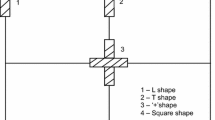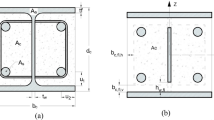Abstract
Composite structures made from the combination of steel profile and concrete have significant loadbearing capacity which depends on the behaviour of the two material components and their interaction, particularly in fire conditions. It is not possible to assess the fire resistance of composite members only by considering the temperature of the steel, because the presence of the concrete may contribute greatly to increase the resistance, strength and thermal inertia of the member, which improves consequently the fire behaviour of the element. The aim of this work is to develop an efficient non-linear 3D finite element model to investigate the behaviour of pin-ended axially loaded composite column made from high strength concrete (HSC) and normal strength concrete (NSC) at different fire rating classes. Two types of column section were selected, notably HEB 160 profile totally encased with concrete and HEB220 partially encased with concrete. The fire behaviour of the columns was tested according to ISO834 standard fire. The results show that the use of HSC in composite columns reduces the level of fire protection with the regard to NSC. NSC in composite structures accommodates higher deflections than HSC, which is safer in case of fire accident. The mechanical resistance in composite columns at room temperature is reduced more than twice after 30 min of fire exposure.


















Similar content being viewed by others
References
Afroughsabet, V., & Ozbakkaloglu, T. (2015). Mechanical and durability properties of high-strength concrete containing steel and polypropylene fibers. Construction and Building Materials,94, 73–82.
Albero, V., Espinos, A., Romero, M. L., Hospitaler, A., Bihina, G., & Renaud, C. (2016). Proposal of a new method in EN1994-1-2 for the fire design of concrete-filled steel tubular columns. Engineering Structures,128, 237–255.
An, Y.-F., & Han, L.-H. (2014). Behaviour of concrete-encased CFST columns under combined compression and bending. Journal of Constructional Steel Research,101, 314–330.
ANSYS INC. (2016). ANSYS ®Academic Research, Release 16.2, Help System, Element reference. Canonsburg: ANSYS, Inc.
Bamonte, P. (2008). On the role of second-order effects in HSC columns exposed to fire. In Proceedings of 5th international conference structures in fire-SiF’08 (pp. 440–450).
CEN. (2004a). European Committee for Standardization, EN 1992-1-2: Design of concrete structures—part 1-2: General rules—Structural fire design, vol. EN 1992. Brussels: CEN-European Committee for Standardization.
CEN. (2004b). European Committee for Standardization, Eurocode 4: Design of composite steel and concrete structures—part 1-1: General rules and rules for buildings. Brussels: CEN-European Committee for Standardization.
CEN. (2005a). European Committee for Standardization, EN 1994-1-2: Design of composite steel and concrete structures. Part 1-2: General rules—structural fire design. Brussels: CEN-European Committee for Standardization.
CEN. (2005b). European Committee for Standardization, EN 1993-1-2: European Standard Eurocode 3: Design of steel structures—part 1-2: General rules—structural fire design, CEN-Europ. Brussels: CEN-European Committee for Standardization.
CEN. (2005c). European Committee for Standardization, Eurocode 3: Design of steel structures—part 1-1: General rules and rules for buildings. Brussels: CEN-European Committee for Standardization.
Chicoine, T., et al. (2002). Behavior and strength of partially encased composite columns with built-up shapes. Journal of Structural engineering,128(3), 279–288.
Espinos, A., Romero, M. L., & Hospitaler, A. (2012). Simple calculation model for evaluating the fire resistance of unreinforced concrete filled tubular columns. Engineering Structures,42, 231–244.
Fellouh, A., Benlakehal, N., Piloto, P., Ramos, A., & Mesquita, L. (2016). Load carrying capacity of partially encased columns for different fire ratings. Fire Research,1(23), 13–19.
Gernay, T. (2016). Fire performance of columns made of normal and high strength concrete: A comparative analysis. Key Engineering Materials,711, 564–571.
Hoang, H. (2010). Structural continuity effects in steel frames under fire conditions. Masters Theses (All Theses, All Years), 420, Worcester Polytechnic Institute.
International Organization for Standardization. (1999). ISO834-1: Fire-resistance tests—elements of building construction—part 1: General requirements. Geneva: International Organization for Standardization.
Kodur, V. (2014). Properties of concrete at elevated temperatures. ISRN Civil Engineering, 2014, 468510.
Kodur, V. K. R., & Khaliq, W. (2011). Effect of temperature on thermal properties of different types of high-strength concrete. Journal of Materials in Civil Engineering,23(6), 793–801.
Kodur, Venkatesh, & Mcgrath, Richard. (2003). Fire endurance of high strength concrete columns. Fire Technology,39(1), 73–87.
Kodur, V. K. R., & Sultan, M. A. (2003). Effect of temperature on thermal properties of graphene. Journal of Materials in Civil Engineering,15(2), 101–107.
Kodur, V. K. R., Wang, T. C., & Cheng, F. P. (2004). Predicting the fire resistance behaviour of high strength concrete columns. Cement and Concrete Composite,26(2), 141–153.
Luccioni, B. M., Figueroa, M. I., & Danesi, R. F. (2003). Thermo-mechanic model for concrete exposed to elevated temperatures. Engineering Structures,25(6), 729–742.
Moliner, V., Espinos, A., Romero, M. L., & Hospitaler, A. (2013). Fire behavior of eccentrically loaded slender high strength concrete-filled tubular columns. Journal of Constructional Steel Research,83(12), 137–146.
Piquer, A., & Hernández-Figueirido, D. (2016). Protected steel columns vs partially encased columns: Fire resistance and economic considerations. Journal of Constructional Steel Research,124, 47–56.
Rodrigues, J. P. C., Correia, A. J. M., & Pires, T. A. C. (2015). On the role of second-order effects in HSC columns exposed to fire. Journal of Constructional Steel Research,105, 97–106.
Schaumann, P., Kodur, V., & Bahr, O. (2009). Fire behaviour of hollow structural section steel columns filled with high strength concrete. Journal of Constructional Steel Research,65(8–9), 1794–1802.
Author information
Authors and Affiliations
Corresponding author
Ethics declarations
Conflict of interest
On behalf of all authors, the corresponding author (Abdelkadir Fellouh) states that there is no conflict of interest.
Additional information
Publisher's Note
Springer Nature remains neutral with regard to jurisdictional claims in published maps and institutional affiliations.
Rights and permissions
About this article
Cite this article
Fellouh, A., Bougara, A., Piloto, P.A.G. et al. Non-linear buckling analysis of composite columns made from high and normal strength concrete under fire. Asian J Civ Eng 21, 17–27 (2020). https://doi.org/10.1007/s42107-019-00180-8
Received:
Accepted:
Published:
Issue Date:
DOI: https://doi.org/10.1007/s42107-019-00180-8




